The iPhone 5 Review
by Anand Lal Shimpi, Brian Klug & Vivek Gowri on October 16, 2012 11:33 AM EST- Posted in
- Smartphones
- Apple
- Mobile
- iPhone 5
Battery Life
Section by Anand Shimpi
At the start of our iPhone 4S battery life analysis I mentioned that I wasn't happy with the current state of our battery life benchmarks. The first incarnation of our smartphone battery life suite was actually a port of what I created to test battery life on Mac notebooks years ago. The Mac suite has evolved over time, and we've made similar evolutions to the smartphone suite - just on a less aggressive pace. The data on the previous page showed just how good Apple is at driving down idle power consumption, and through some software optimization it got very good at winning in our battery life tests. The data was accurate, but stopped being representative of reality.
Going into the iPhone 5 review I knew we needed to change the suite. After testing a number of options (and using about 16.5GB of cellular data in the process) we ended up on an evolution of the battery life test we deployed last year for our new tablet suite. The premise is the same: we regularly load web pages at a fixed interval until the battery dies (all displays are calibrated to 200 nits as always). The differences between this test and our previous one boil down to the amount of network activity and CPU load.
On the network side, we've done a lot more to prevent aggressive browser caching of our web pages. Some caching is important otherwise you end up with a baseband test, but it's clear what we had previously wasn't working. Brian made sure that despite the increased network load, the baseband still had the opportunity to enter its idle state during the course of the benchmark.
We also increased CPU workload along two vectors: we decreased pause time between web page loads and we shifted to full desktop web pages, some of which are very js heavy. The end result is a CPU usage profile that mimics constant, heavy usage beyond just web browsing. Everything you do on your smartphone ends up causing CPU usage peaks - opening applications, navigating around the OS and of course using apps themselves. Our 5th generation web browsing battery life test should map well to more types of smartphone usage, not just idle content consumption of data from web pages.
As always we test across multiple air interfaces (3G, 4G LTE, WiFi), but due to the increased network load we actually find that on a given process technology we see an increase in battery life on faster network connections. The why is quite simple to understand: the faster a page is able to fully render, the quicker all components can drive down to their idle power states.
The downside to starting with a new battery life test is that we don't have a wealth of older data to compare to. I did my best to run whatever we had access to at the time, but there simply aren't that many devices in these charts compared to our older ones. The data below may not look like a lot, but it's the result of running over 300 hours of battery life tests to not only understand how these devices do under load but also to find out the best test to use as the cornerstone of our new suite.
We'll start the investigation on WiFi. Where supported we used 5GHz 802.11n, otherwise 2.4GHz:
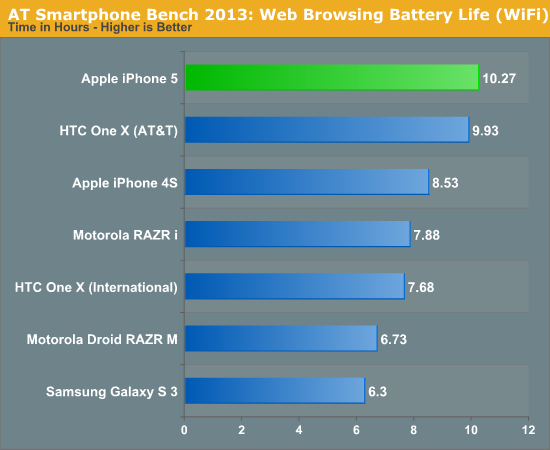
The iPhone 5 manages to match Apple's estimates, just breaking the 10 hour barrier. HTC's One X based on the Snapdragon S4 comes very close however. Although the One X is equipped with a larger battery, it also has a bigger screen and slightly more power hungry SoC to feed as well.
The iPhone 4S is measurably worse here. Keep in mind that the workload between all of the devices here is constant, if you use the faster performance on the iPhone 5 to browse more web pages or use your apps quicker then you may not see an improvement here. Worst case, you may even see a regression in battery life. That's the downside to this increased dynamic range in power consumption that we've been getting for two generations now.
Although this isn't the place for an Intel/Qualcomm comparison, it is important to note that the Atom Z2460 based RAZR i manages to last 17% longer on a single charge than the nearly identical, but Qualcomm S4 based RAZR M.
Next let's look at battery life when we switch to the cellular networks:
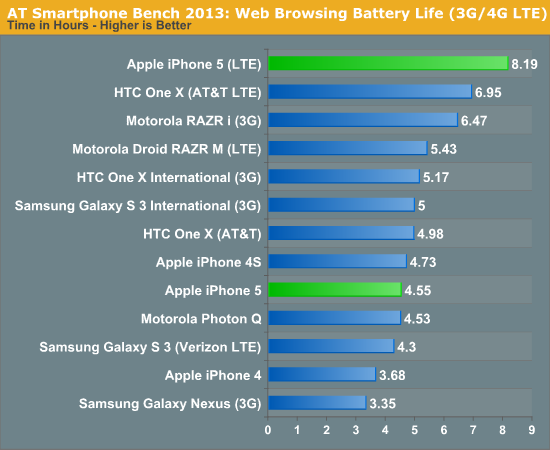
The non-LTE phones see a sharp drop in battery life. At least at 28nm the slower air interfaces simply have to remain active (and drawing power) for longer, which results in measurably worse battery life. Again, the thing to be careful of here is there's usually a correlation between network speed and how aggressive you use the device. With a workload that scaled with network speed you might see closer numbers between 3G and 4G LTE.
HTC's One X continues to do very well on LTE, coming the closest to the iPhone 5. I believe what we're seeing here is really Apple's idle power management building up a small but tangible advantage.
On 3G the iPhone 5 actually dies slightly quicker than the iPhone 4S, although run to run variance can cause the two to flip around in standings. Our iPhone 4 datapoint featured an older battery (both the 4S and 5 batteries were < 30 days old) so it's unclear how a brand new 4 would compare.
The RAZR i does quite well here on 3G. Despite being on a slower network, Intel's platform appears to do a good job of aggressively pushing down to idle. Once again Intel maintains about a 19% battery life advantage over the S4 based RAZR M. The RAZR i and the HTC One X do better than the iPhone 5 on 3G, which supports our theory of idle power consumption being a big reason the iPhone 5 does so well on faster networks.
While our new web browsing battery life tests do a good job of showing the impact of network, display and CPU on battery life, they do little to stress the GPU. Thankfully our friends at Kishonti gave us a shiny new tool to use: GLBenchmark 2.5.1 features a GPU rundown battery life test. The standard tests run Egypt and Egypt HD indefinitely until the battery life dies. We standardized on using Egypt HD at the device's native resolution with a 30 fps cap. All of the displays were calibrated to 200 nits as usual.
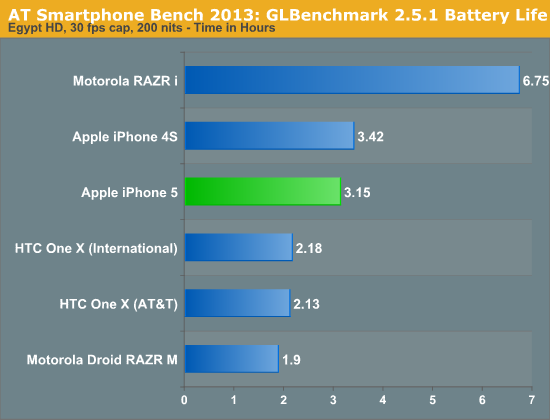
Here the iPhone 4S has a tangible advantage in battery life over the 5. The move to 32nm can only do so much, with many more transistors switching at a higher frequency the A6 SoC ends up drawing tangibly more power than the A5 in the iPhone 4S and delivers a shorter run on battery. The gap isn't huge (the 5 delivers 92% of the battery life of the 4S), but it's still a regression. The iPhone 5 does comparatively quite well here, despite being faster it's able to outlast the S4 and Tegra 3 based devices. The explanation is rather simple: capped to only 30 fps the iPhone 5's GPU likely has the ability to drop down to an idle state for a brief period in between rendering frames. The other devices can't hit 30 fps in this test and as a result have to run at full tilt throughout the entire benchmark. The RAZR i is the only exception to the rule, but it is considerably slower than everything else here (averaging below 8 fps) which could explain the very high result.
Moving on we have our WiFi hotspot test, which measures how long the device can last acting as a hotspot for a wirelessly tethered notebook. Our wireless hotspot test is entirely network bound by its definition. Here I'm including two sets of results, our most up to date LTE hotspot battery life tests as well as the chart we included in our latest iPad review. In both cases the iPhone 5 does relatively well, lasting just over 5 hours as an LTE hotspot on a single charge. In these tests, devices with significantly larger batteries come in very handy.
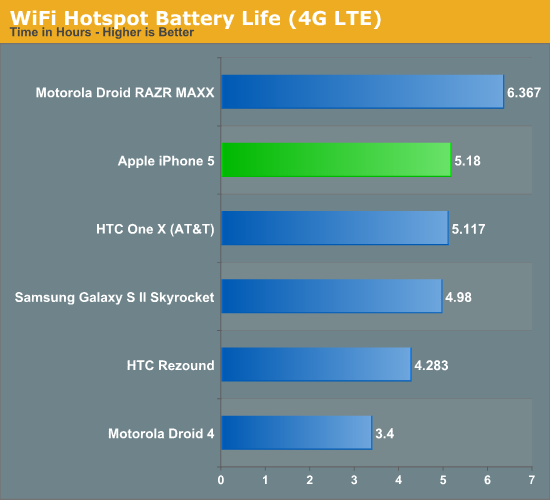

Our final battery life test is our standard call time test. In this test we're playing audio through two phones (one of which is the phone being tested) and measure the call time until the battery is completely drained. The display is turned off, simulating an actual call.
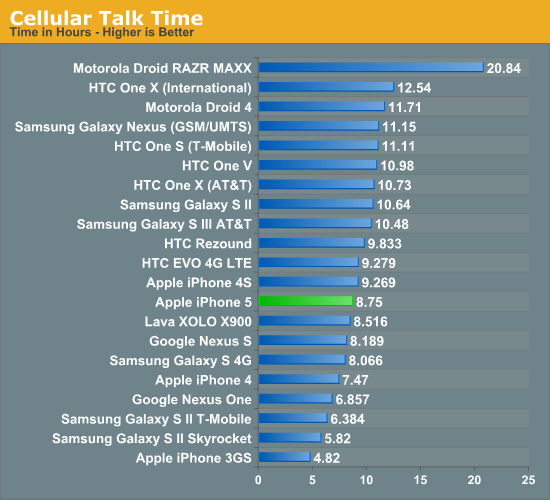
The iPhone 5 falls just short of the 4S in our call time test. There's really no major improvement here as far as we can tell, although it's not clear how much additional work the iPhone 5 is doing with its additional noise cancelling features. If talk time is of the utmost importance to you, you'll want to look at some of the phones with much larger batteries. The Droid RAZR MAXX remains the king of the hill as far as talk time is concerned.
Battery Life Conclusions
If we take a step back and look at the collection of results from our battery life tests, the iPhone 5 can last anywhere between 3.15 and 10.27 hours on a single charge. Do a lot of continuous data transfers and you'll see closer to 5 hours, but if you've got reasonably periodic idle time you can expect something in the 8 - 10 hour range. In short, if you use your device a lot, don't be too surprised to see it lose about 10 - 15% of its battery life for every hour of use.
Now the question is how does the iPhone 5 compare to other devices? Compared to previous iPhones, the 5 has the ability to use a lot more power. If you're doing the exact same, finite length CPU/network intensive task on the iPhone 5 and any previous iPhone, chances are that the iPhone 5 will be able to complete the task and get to sleep quicker - thus giving you a better overall energy usage profile. Where things get complicated is if you use the faster CPU, GPU and network connectivity to increase your usage of the device. In that case you could see no improvement or even a regression in battery life.
Compared to other modern platforms the iPhone 5 should be competitive in day to day power usage, even compared to devices with somewhat larger batteries (~7Wh). The trick to all of this of course is whatever performance advantage that the iPhone 5 has coupled with lower idle power. Being able to complete tasks quicker and/or drop to aggressively low idle power states are really the only secret to the iPhone's battery life.
I feel like the days of ever increasing smartphone battery life are behind us. Instead what we'll likely see going forward is continued increase in dynamic range. Battery life could be better or worse and it'll likely depend heavily on your workload. Much like how we saw notebooks cluster around the same 2 - 5 hour battery life for years, I suspect we'll see something similar here with smartphones. The major difference this time around is the burden of a really large battery isn't as big as it is in a notebook. The RAZR MAXX is the perfect example of a still very portable smartphone that comes equipped with a huge (by today's standards) battery.










276 Comments
View All Comments
rarson - Thursday, October 18, 2012 - link
Me too, other than the stupid proprietary connection that jacks the price of everything up.Spunjji - Friday, October 19, 2012 - link
I sit pretty firmly in this camp, too. Despite the physical durability flaws, I do find the overall package of the iPhone 4/4S/5 to be superior to most comparable 'Droid handset. I just find the software to be unbearably obstructive to my desired use patterns.steven75 - Wednesday, October 17, 2012 - link
Maybe some people want a still larger display but keep the industry leading app support, industry leading hardware ecosystem, airplay, apple store support, industry leading resale value, industry leading OS upgrade support, and without any carrier bloatware?Seems pretty possible to me.
GotThumbs - Tuesday, October 16, 2012 - link
"we've just got to deal with it." Wrong. You have to "deal with it".Believe it or not....everyone does NOT own one of these phones. The idea of getting a brand new item, be it a car, camera, laptop, tablet or phone and having to deal with the fact that that the companies quality controls are sub-standard is one of the lamest things I've heard....Oh! besides the number one example...... "You're holding if wrong" - Steve Jobs.
I try to not let this kind of monologue that reeks of Apple fanism not bother me...but come on! Talk about romancing about a freaking phone. Please keep it to a level of unemotional comparisons and the feel free to give your personal thoughts and not assume to speak for everyone else.
The fact that you felt compelled to write 5 or more paragraphs on the anodizing process is just pathetic. I stopped reading about it after the first paragraph and skipped to the bottom. I thought this is supposed to be a phone review, not a discovery channel episode on the anodizing process. I can't speak for you or anyone else, but I'm pretty comfortable telling you most consumers probably don't care about the process of anodizing, they just expect a quality product for their money.
People are paying good money...in a bad economy and your saying all they can do is "deal with it"? How about having an open mind and mention they have the choice to buy a different phone or wait for Apple to fix it in their next generation. Your only position appears to be....suck it up, its Apple and thats just part of being in the collective.
Again,,,,, YOU do not speak for everyone so please drop the "WE".
Rant done.
Best wishes to all on your choices in life.
crankerchick - Tuesday, October 16, 2012 - link
Talk about overreaction. Keep the statement within the context of the article. iPhone users have to deal with it if they want to remain iPhone users. Anand is an iPhone user as well are more than a few people reading his review--thus the use of the word "we" instead of the use of the term "iPhone users."That said, he should take care lose the "we" but wow, what a rant for something that one can easily use common sense and say, "No I'm not stuck with it." Other bloggers and review sites do the same thing.
LOL, everyone is always looking for someone to point the fanboy finger at.
KPOM - Tuesday, October 16, 2012 - link
Apparently you have never read an AnandTech review. They go into that kind of detail all the time. That's what people like about them. You aren't going to read that in a CNet, The Verge, or Engadget article. You might get some of that at Ars Technica. But AnandTech goes into excruciating detail.VivekGowri - Tuesday, October 16, 2012 - link
I mean, it's not like Apple is going to radically alter it a month after production starts, so if you want an iPhone 5, your options are to either put a case on it, or suck it up and live with the scratches. Alternatively, you could buy a 4S (if you want iOS) or any other phone that floats your boat.I'm a guy that daily drives a Galaxy Nexus, so accusing me of iOS fanboyism isn't necessarily the most productive way of going about your day.
phillyry - Sunday, October 21, 2012 - link
Yes!Well said Vivek.
But ya, Apple should still have the pressure put on them. So, I could see how people might take it the wrong way. 'Cause it could seem like you're just like, "It's all good Apple, we'll just suck it up." When, in actuality, your ideas are as you stated here. As per the OP's rant, I definitely thought it was off-base but could see where he would draw that conclusion, as it came across that way to me too. And, perhaps like me, he has a hard time keeping track of who uses which phone from the podcasts.
Again, well retorted though.
jiffylube1024 - Tuesday, October 16, 2012 - link
You are seriously complaining about the depth the review went into on the anodizingprocess? You're reading a review of a product and you're complaining that you're being given more information? How about you just skip over that section if it doesn't interest you.
I lol'ed that you called that kind of serious scientific investigation into the anodizing process (which I found incredibly informative) "pathetic". Real, fact-based journalism apparently bores you; you'd just rather read opinion pieces and pass judgment on them. How high minded of you!
Other reviews don't even mention anything about the anodizing process other than that it's there. I don't get why you'd even bother reading a review on AnandTECH if you don't care about the technology...
As for the author's position to "deal with it" (the anodization scratch issue) -- what more can the author do? He can't fix the problem or even address it from a manufacturing standpoint. The review points out the issues with it; the decision making process is up to the consumer and the fixing of the problem is up to the manufacturer.
GotThumbs - Wednesday, October 17, 2012 - link
"Other reviews don't even mention anything about the anodizing process other than that it's there. I don't get why you'd even bother reading a review on AnandTECH if you don't care about the technology..."Anodizing a piece of aluminum does not constitute "technology" when compared to the design of a SoC or camera, at least in my opinion. I see it as a finishing process. My point is that a side link to more detailed information on the anodizing process would have sufficed and kept the reader on track with the hardware review.
I visit Anandtech on a daily basis and have been reading/visiting this site from the early years when Anand was still in High School. I thoroughly enjoy reading/learning about how new technologies in hardware are evolving and when they are compared to other current hardware available in the marketplace. But I feel there has been a growing tendency in Apple product reviews to have a hint of personal/emotional input rather than sticking to an analytical/technical assessment and let each reader digest the information without the personal emotional spin. It's like todays "News" casters interjecting thier personal thoughts/opinions on a news story. I prefer to get the facts and come to my own conclusion.
In case you haven't realized, more and more in todays society, we are "Marketed to" in ways that are growing exponentially. Todays marketing companies continue to market to us using methods not just like Product Placement in TV shows, Reality shows, Movies, Red Carpet runways. etc., but on FB, Twitter, blogs, and weak "tech reviews" like CNN's (Read more like product ads than a review) etc. Because of this bombardment of marketing from every possible source imaginable and newly evolving, I don't think its wrong to call out a reviewer when I feel there is even a whiff of non-neutrality. They can take it with a grain of salt or ponder on their next review to be sure they are approaching it in a clear and unbiased manner.
Complacency in a society and lowering on one's expectations is not something to embrace, its to be challenged and called out.
Listen, no one is perfect and yes I may have been a little high strung in my post, but it was fueled by emotion and passion and I won't apologize for that.
I do apologize to Vivek Gowri if I offended him in any way. It was not my intent.
Best wishes